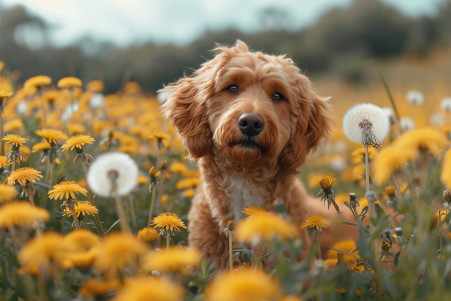Can Dogs Eat Ants? Risks and Benefits Explored
24 April 2024 • Updated 23 April 2024

Dogs are naturally curious animals, and when they're out and about, they may be tempted to eat the ants they come across. But is it safe for dogs to eat ants? In general, dogs can eat ants without any problems, as ants are not poisonous to dogs. However, fire ants, carpenter ants, and ants that have ingested pesticides can sting or bite dogs and cause skin irritation. That said, while it's unlikely, eating too many ants could lead to digestive issues.
This article will explore the potential risks and benefits of dogs eating ants, as well as expert insights on whether or not this behavior is recommended. By examining evidence from veterinary medicine, entomology, and animal behavior research, we aim to offer a well-rounded view that will help you decide whether to curb or condone your dog's love of ant treats.
Can dogs eat ants?
Fire Ants and Their Venomous Stings
Of all the ant species, fire ants are one of the most dangerous to dogs because of the venom in their stings. According to a National Geographic article, there are more than 10,000 species of ants in the world, but fire ants are unique in their ability to sting and inject venom.
The venom in fire ant stings contains an alkaloid called piperidine, which is a derivative of piperine, the compound that gives black pepper its heat. Piperidine is known to cause intense local irritation and swelling at the site of the sting. According to Embrace Pet Insurance, the stings cause raised, red areas on the skin that are extremely itchy and uncomfortable for dogs. Pustules or blisters filled with fluid may also develop at the site of the sting.
In addition to these local reactions, fire ant stings can also cause anaphylactic reactions in dogs. Signs of anaphylaxis, which are described by the Pet Poison Helpline, include difficulty breathing, weakness, seizures, and pale or bruised skin. If a dog is stung by several fire ants at the same time, the amount of venom they receive can increase the severity of their reaction, so it’s important to seek immediate veterinary care to help manage their symptoms.
While not all dogs will have severe reactions to fire ant stings, the potential for danger is high enough that pet owners should be concerned. It’s important to seek immediate care if a dog shows signs of distress after being stung by these venomous insects. By learning about the dangers of fire ant stings, pet parents can take steps to help protect their dogs from this painful threat.
Nutritional Value and Benefits of Ants for Dogs
While ants may not be the first thing that you think of when it comes to feeding your dog, some species can offer nutritional benefits. According to Healthline, leaf-cutting ants and weaver ants are two of the most popular edible ant species in the world. These ants can be a great source of protein, with some species containing up to 53 grams of protein per 100 grams.
In addition to protein, ants contain some vitamins, minerals, and antioxidants that can be good for your dog. Animal Gator explains that ants can help with your dog's general health by providing essential amino acids. That said, they also explain that ants should be used as a treat and not as a main food source.
While the nutritional benefits of ants are important to note, it's also important to be careful when it comes to feeding them to dogs. The next section will cover the proper preparation and precautions you should take when introducing ants into your dog's diet.
How to Feed Ants to Dogs: Preparing and Safety
For dog owners who want to feed ants to their pets, it's important to make sure that the ants are non-toxic and come from an area that has not been sprayed with pesticides or insecticides. Animal Gator suggests that the ants be cleaned and prepared before being given to dogs to ensure that they are free from contaminants and parasites.
It's also important to watch dogs for any signs of distress after they eat ants. Rover.com warns that eating a large number of any type of bug can lead to gastrointestinal upset, including symptoms like nausea, vomiting, drooling and diarrhea. In addition, Pet Poison Helpline suggests that dog owners watch for signs of an allergic reaction. It's also a good idea to talk to a vet before feeding ants to dogs on a regular basis since they should be an occasional treat.
With these safety measures in mind, dog owners can let their pets explore their interest in ants without putting them at unnecessary risk. However, it's important to be cautious since eating the wrong kind of ant or too many ants can be dangerous.
Dangers of Eating Ants: Parasites, Poisoning, and Allergic Reactions
Dogs that eat ants may be at risk of getting parasites or worms, such as tapeworms or stomach worms. According to PetMD, ants can carry parasites like tapeworm that can be transmitted to dogs if they are eaten.
Eating ant traps or ants that have been exposed to insecticides can also lead to poisoning in dogs, which can cause symptoms like vomiting and diarrhea. As mentioned by Wagwalking.com, ant poisons are made to be less toxic to pets, but eating the traps themselves can still lead to poisoning in dogs.
In addition, some dogs may be allergic to ant bites or stings, and their reactions can range from mild to severe. Peaceful Paws Pet Care warns that spider and bee/wasp stings can release venom if a dog eats them, which can lead to issues.
If a dog eats a large number of ants or is showing signs of illness, such as vomiting, lethargy, or trouble breathing, it's important to get them to a vet right away. Getting treatment as soon as possible is important for managing the potential dangers of eating ants.
How to Avoid Ant Consumption: Tips for Pet Owners
To avoid dogs eating ants, pet owners should make sure to keep pet food bowls clean and store dog food inside to deter ant infestations. While it is fairly common and harmless to find one or two ants in a dog's food, a larger infestation can be a problem, according to Emotional Pet Support.
It is also important to avoid using toxic ant baits or sprays in areas where pets can access them, as these can be toxic if ingested, according to the Pet Poison Helpline. Instead, Barking Dog Bakery & Feed suggests that pet owners keep their dogs away from ants using positive reinforcement training and close supervision during outdoor play and exploration.
These measures can help pet owners ensure that their dogs don't eat ants while still allowing them to explore and satisfy their curiosity.
Conclusion: Finding a Healthy Middle Ground
Although the average dog's occasional eating of everyday ants is mostly safe, it's important to understand the potential dangers. Toxic ants like fire ants and ants that have come into contact with pesticides are best to stay away from to avoid stings and potential poisoning.
It's also important to remember that too many ants can cause digestive upset and the potential for parasites. However, with the right care and attention, dog owners can help their pets explore their curiosity while keeping them safe.


